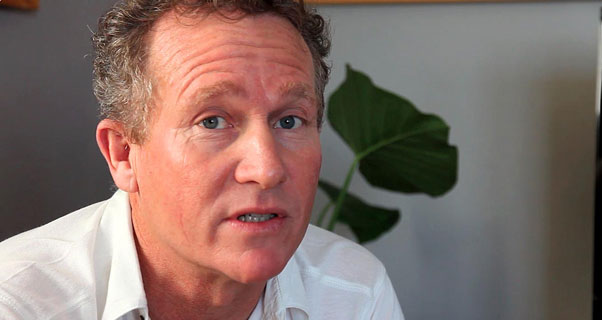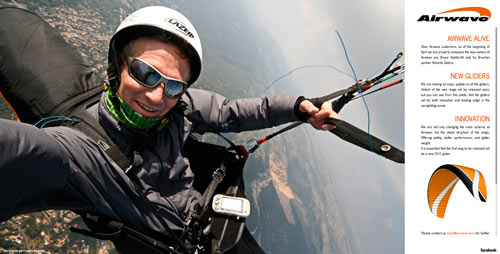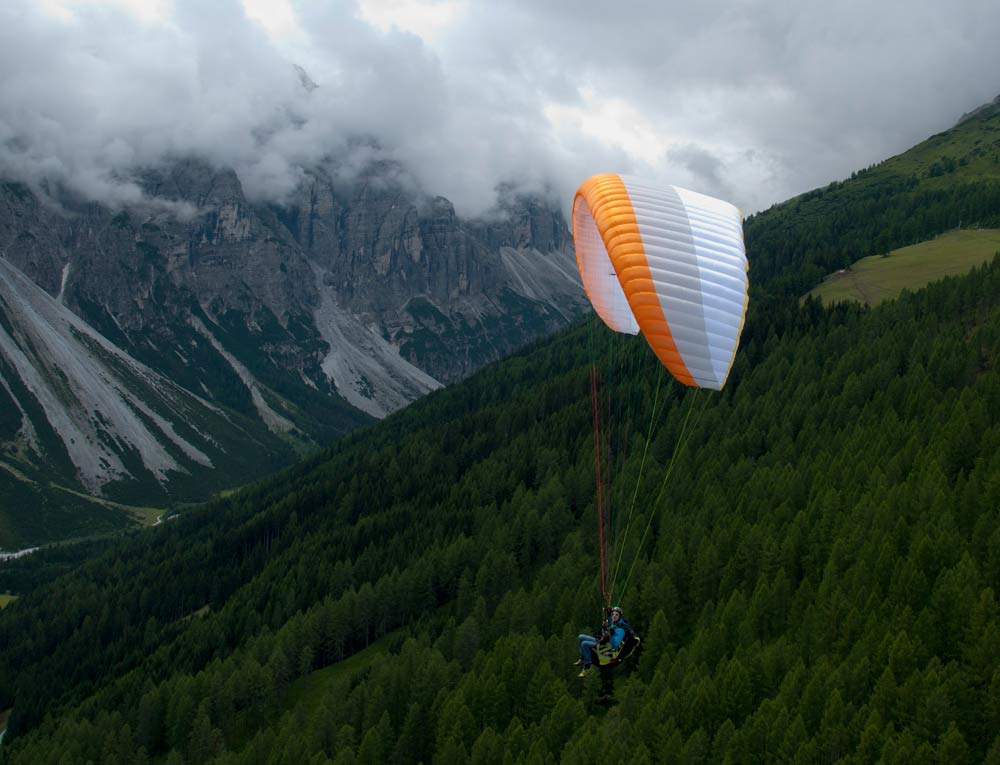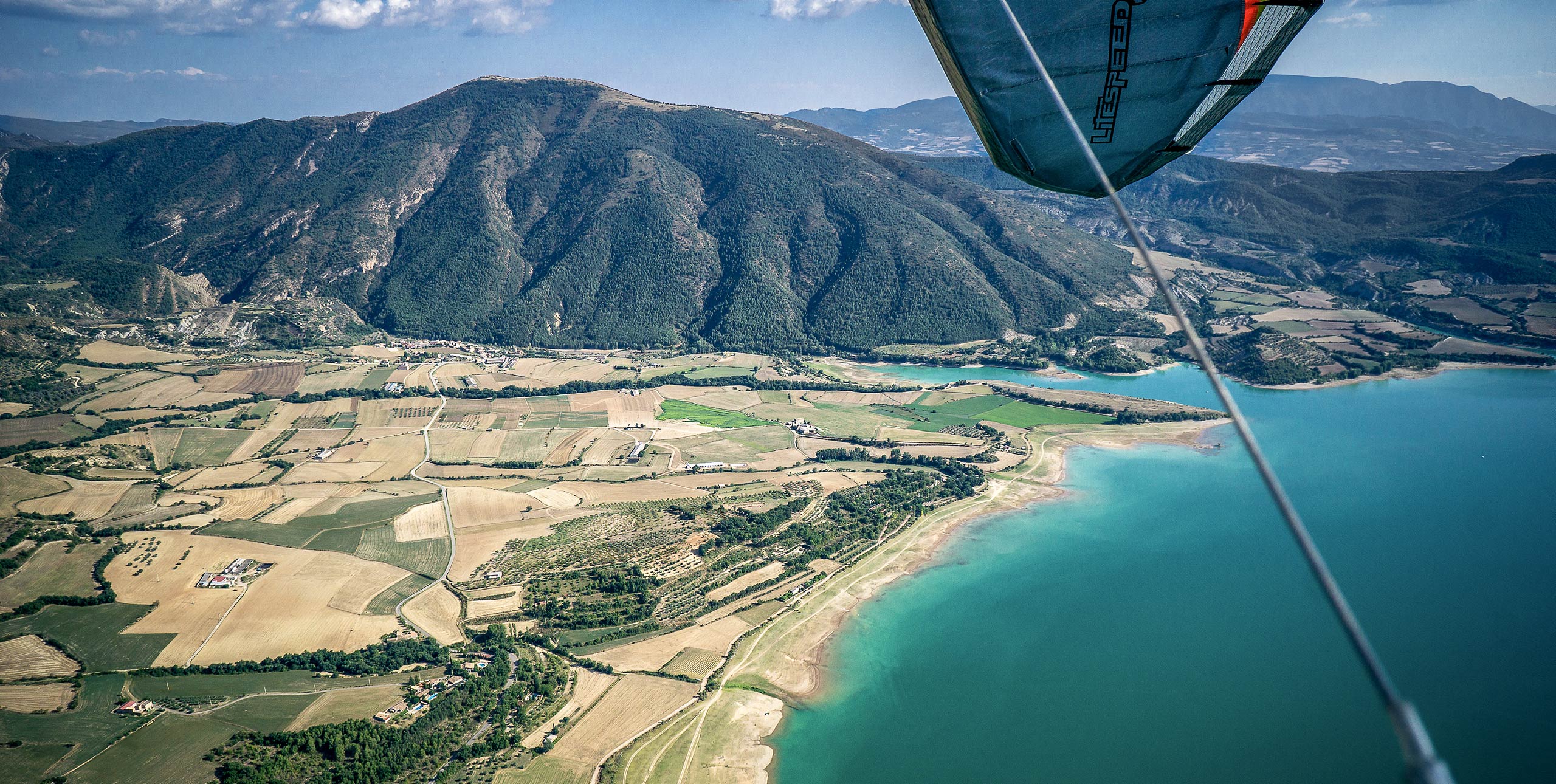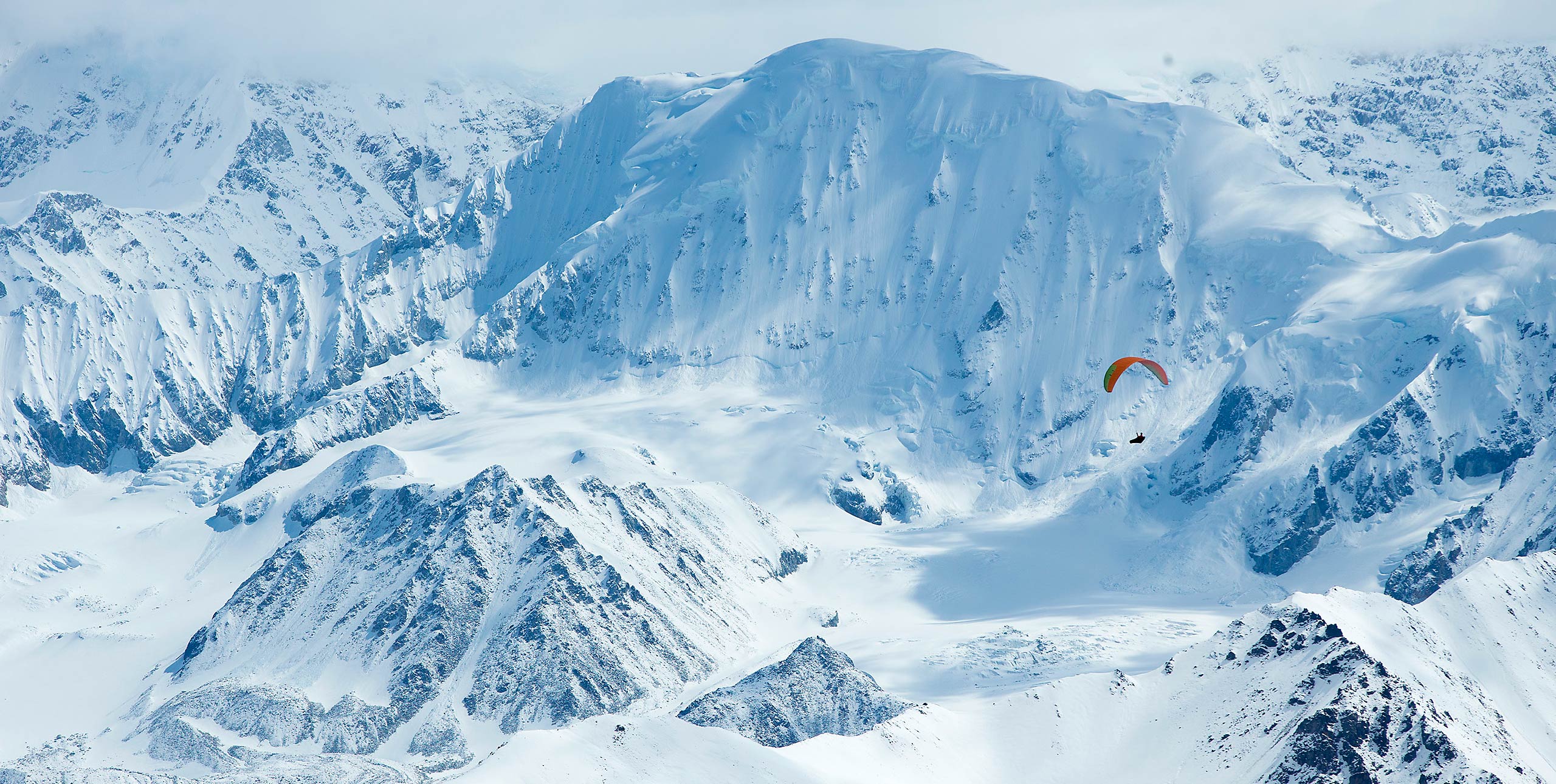[youtube id=”oSgpkDKGQuA” w=”500″]
XCmag TV: Martin Gostner introduces Airwave gliders in 2007
Three years ago, you wouldn’t have been alone in laughing behind Markus Villinger’s back as the Austrian businessman bought up the virtually defunct Airwave brand. But Airwave has proved itself to be a modern-day Phoenix, rising from the ashes of bankrupcy to reclaim a strong position in the international flying market. Markus talked to Hugh Miller about the trials and tribulations of turning Airwave around. Published in Cross Country magazine in 2003
What were you up to in the flying game before you bought Airwave in April 1999?
I headed up Wills Wing Europe throughout the ’80s and ’90s and during that time Airwave was actually my biggest competitor, by far. I sold WW Europe in 1997. Then at the Free Flight Show in 1999, Monique Werner told me that Airwave was in trouble. That was the first I heard of it. I caught up with Airwave’s Managing Director Rory Carter and told him quite directly, “I hear you’re in trouble”. He was very open and said, “Yes, it’s true.” I told him I was interested, and a week later I flew over to the Isle of Wight, UK to check it out.
That must have been interesting. Can you describe the scene you came across at the old factory?
The place was virtually shut down, it was really sad. It had a big office, kind of messy, with computers and phones scattered around the place. It looked like everyone had left in a hurry, cleaning the place out of anything valuable. There were some gliders left, but only the older models. Rory said, “Hurry up, or it’s all gone.” I bought the whole package from the receivers.
So where did you see the worth in Airwave?
After I sold Wills Wing Europe in ’97, I had this idea to build a skyfloater and market it under my own name. It didn’t work out that well. I learnt an early lesson: a known brand is really valuable in flying. People know me in the industry, but pilots don’t know me as a designer. Conversely, Airwave still had big brand recognition among grassroots pilots. You’ve got to remember that a year before they went bust, Airwave won the World Championships with John Pendry.
When you took over, were you aware that the Airwave brand carried a slightly arrogant image and perhaps wasn’t the most popular of companies?
Not really. Everybody has friends and enemies and no company in the world only has friends. When Airwave went bust, quite a few dealers and customers got burnt. I’ve always had a good name for paying suppliers and being fair, and I’ve been in this business for 25 years. When I took over Airwave we had a real problem regaining the trust of suppliers. Even now we still have to pay up front for some things. Everything you see at Airwave now, all the gliders, it’s all paid for, there’s no credit. It’s a very straight way of doing business, but in the beginning it was tough with lots of cash flow problems.
At the time, Rory Carter blamed part of Airwave’s failure on their expensive paragliding competition team. Would you agree?
For sure, supporting a big team costs too much money. In the early ’90s, sales were really good but now times are tougher. The only company so far to get away with a big competition team is Gin Gliders, and there’s a reason for it. Most of Gin’s competition team pay for their own gliders! Sponsoring factory pilots is a very, very dangerous thing to do. Remember UP in the early days? Back in the early ’80s they won all the championships and 50 out of 100 pilots at the Worlds were flying the UP Comet. That same year they went bust. Anyhow, competitions don’t help sales that much. Most people don’t even know who the current World Champion is. Airwave had other problems: too many staff, high labour costs with a factory in the UK, and ultimately not enough expertise in hang gliding.
Your background is in hang gliding. Where did you see paragliding fitting into the new Airwave?
I didn’t have a firm vision as to which area I’d concentrate more on. I come from a hang gliding background, though I founded paragliding companies Airman and STV back in the ’80s so I had some ideas about the business side of it. We released our first Airwave paraglider, the Epic, in 1999. I contracted Stefan Muller, a freelance designer who worked mainly for Firebird, to do the design, and I was happy to tell people that. But I soon realised that the designer’s name is really important to the brand. Names like Hannes Papesh, Gin Seok Song and Robert Graham
– these guys are the heroes. I met up with another renowned designer, Michael Nestler, early on. Michael now designs for fifteen different companies and I don’t think this is really the way to become one of the leading manufacturers.
Has there been a particular turning point in the last three years, a key moment when you felt you’d turned Airwave around?
Initially I poured a lot of money from my real estate business in, to get Airwave going again. DHV tests, advertising, rent, employees – it all adds up. You know how much a company costs just to run. Every month costs so much, and it goes on for so long, and then it’s over. Then Bruce Goldsmith came back. He was important, no doubt about it. But when we released the Magic in November 2000, the sales started coming in. Until then we were selling Epics and Harmonies, but it wasn’t great. With the Magic I saw a future.
How’s it gone since then?
I know the real size of this industry and I know that the Magic has gone really well. For 2000, I had the goal of selling a total of 600 gliders to break even, which we managed. In 2001, we sold 1,100 Magics – it was phenomenal. Then this past year, we’ve sold 1,800 gliders altogether. This is a true figure, not just hype. I know there are other manufacturers around who sell more, but I think we’re there, you know?
Absolutely. Are there any key things you’ve learnt over the last three years about business or flying?
That paragliders are fantastic. A while ago I used to think, Yeah, those bags. It was like, “Ok, let’s do it for business.” But I was one of the first guys in paragliding. Back in 1985, I met up with Gin Seok Song and agreed to distribute his first design, the Airman range. But after a while I sold the company to go back to hang gliding. Now, when I see Bruce and his guys flying, my eyes are stretched wide open to the sport’s possibilities. You can take a paraglider deep into the mountains where you’d never be brave enough to fly a hang glider, and land in really tight spots. A paraglider is just a great aircraft. With regards to the business, I’ve been dealing hang gliders since 1976, working with seven or so employees, and that side is the same whether you sell hang gliders or paragliders.
It seems like Wills Wing Europe was a fairly successful operation for you. Was there any particular reason why you decided to sell it?
I guess I did it for many years and kind of got sick of it. There were some personal reasons too. You remember the Wills Wing Ram Air back in 1992? That was my concept. We sold a lot of gliders with some great promotion, and basically we cleaned up. Our competitors were just waiting to find something wrong with the design, and when someone tumbled his Ram Air everyone made a massive issue about it. In my opinion, Wills Wing’s reaction was wrong – they should have stood up and said it was still a safe glider.
With hindsight we now know the Ram Air was no safer or less safe than any other glider was at that time. Also, a long time ago, I had the opportunity to sign Manfred Ruhmer before he became famous. I knew he was a red hot talent and got a contract prepared for him to work for us, and told the Wills guys, “Hey, I want to hire this new guy Ruhmer to help you design gliders.” They wrote back and said, “That’s fine if he wants to drill holes and fly our gliders in competitions but the design takes place here in California.”
Hey, it’s all in the past, the Wills guys are all good friends of mine and Airwave are now distributing Wills Wing in Europe. They’re an excellent brand, and I respect their design, it’s just I guess I wanted a bit more autonomy and control at the time.
What percentage of your sales is from hang gliding as opposed to paragliding?
Let’s just say it’s significantly less than 20%.
So where do you see hang gliding going in the next few years?
I’ve always been one of those guys who thought it was coming back, but now I don’t know. The UK, USA and Australia are more stable and it’s actually growing in the States. But paragliding has also levelled out, or is in decline, but it’s still a much bigger community.
Is there anyone you really respect within the industry?
Everybody who is in this industry is good in some way otherwise they wouldn’t be around. I especially respect Gin, Apco, Nova, Swing and Advance. There’s still a bit of awkwardness between Bruce and Ozone, but things are getting better. This whole split up thing reflects a little into the whole company but we’re kind of over that. The way Ozone promote their gliders is great: they’ve got real personality and enthusiasm.
What else is in the pipeline for you?
Did I tell you we’re designing this idiot-proof paraglider, a low end DHV 1 trainer for schools? It’ll be a glider that doesn’t perform at all well, but can be flown by anybody, which is what most people want! Even a Logic has too much performance – if there’s a little bit of lift, then the student is going to go up. I was talking to Bruce and said, We have all these gliders that perform so well, and we need something that is basically, a dog. A trainer. So that’s what we’re working on, but obviously we’re going to work on the name too!
Any other plans for the future?
No, I’m in the business for the long term. It’s way more fun doing business in free flight than real estate. I enjoy working with passionate people and coming up with creative ideas. There are always so many new things coming up.
• Got news? Send it to us at news@xccontent.local. Fair use applies to this article: if you reproduce it online, please credit correctly and link to xcmag.com or the original article. No reproduction in print. Copyright remains with Cross Country magazine. Thanks!
Subscribe to the world’s favourite hang gliding and paragliding magazine


